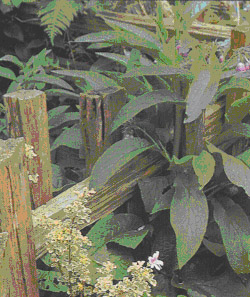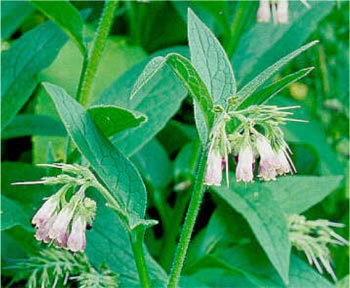
Symphytum officinalis –
photo by Jeanne Rose
COMFREY HEALING
by Jeanne Rose
www.JeanneRose.net
Herbal Classes & Herbal Studies Course
There is a great a deal
of fear now among those who appreciate natural healing methods if
they wish to use the herb and root of Comfrey, Symphytum
officinale. When I started my Herbalism practice in 1969,
Comfrey was one of the mainstays in herbal healing. The leaf was
used in green drinks and for internal healing while the root was
used as an external application to heal wounds and sores. It is an
important herb in organic gardening, having many medicinal and
fertilizer uses. Now there is the fear that drinking the tea will
cause liver disease. However, only two cases were ever reported and
both were found to be from excessive use of the tea.
Years ago, when I wrote
the book,
Herbs & Things, which is still
available and one of the texts of the “Herbal
Studies Course, I discussed the use of the plant.
Plant Use:
The root and foliage of this
plant contains allantoin, a nitrogenous crystalline substance that
is a cell proliferant — that is, it increases the speed at which a
wound heals and broken bones knit back together. Hence, the country
name of ‘knitbone’. Modern science confirms that Comfrey can
influence the course of bone ailments. Generally, Comfrey was used
to treat a wide variety of ailments ranging from bronchial problems,
broken bones, sprains, arthritis, gastric and varicose ulcers,
severe burns, acne and other skin conditions. It was thought to have
bone and teeth building properties in children.
Internal Use:
Taken as a tea, the leaf is
considered a superior demulcent and astringent with superior healing
qualities. This tea (with other appropriate herbs) is also drunk to
relieve the symptoms of asthma and rheumatism and arthritis. Eat a
raw leaf daily for an ulcer or use a teaspoon of the powder of the
leaves in soup. Remember to take this as a course of treatment not
an every day ingestion.
A daily 4 oz drink of
Comfrey leaf, Alfalfa plant and Parsley herb mixed with fruit or
vegetable juice is a marvelous tonic and efficacious for general
health. Just put a leaf or two of each plant in the blender along
with the juice and blend until smooth.
External Use:
The roots is fresh, are
mashed, heated and used as a poultice to relieve the pain of gout,
rheumatism and arthritis. It will also heal cuts, and open wounds. A
poultice of the fresh bruised leaves laid on a wound or burn will
soothe and allay inflammation and cause the edges of the wound to
come together and it will heal more quickly. This is a wonderful
healing, therapeutic ingredient in Jeanne Rose’s famous
Bruise Juice.
It is one of the main herbs in the five classifications needed to
make the Bruise Juice. [emollient/therapeutic or
healing/aromatic/astringent/antiseptic.]
Feminine Use:
As a douche it will cleanse the vagina and cure the ‘whites’ which
is a term for vaginal discharge. A leaf compress can be used for
sore, swollen breasts. In the past, Comfrey was used in treating
'many female disorders’ and especially Comfrey baths were popular to
repair the torn hymen and thus 'restore virginity'.
Cosmetic Use:
Comfrey is one of the most
useful plants in the herbal cosmetic chest. See the formula pages of
Herbal
Body Book, and on page 69 and page 97 of
Kitchen Cosmetics for its many uses. As a cosmetic
and bath herb, with continuous use, it regenerates aging skin. Use
the herb along with Rosemary. I have been bathing in these two herbs
since 1969, and though almost 40 years have passed, I still have
firm attractive skin.
Growing:
This is an easy plant to grow. It will thrive most anywhere. And if
you cannot purchase the dried leaf from an herbal shop, or fear the
government taking away your right to use this plant, just grow it. I
have a shady corner near my Musk Rose, where it gets up to three
feet high and bears bluish-purple flowers most of the summer. Here
in San Francisco the summers are cool, wet and foggy. Comfrey grows
very well.

COMFREY IN THE
GARDEN
Garden
Fertilizer: Take some of the
plant, and infuse in water for up to 2 weeks. Then use the water as
a fertilizer. You will need about 1/2 pound of the fresh pant (or
your garden cuttings) to 1-gallon of water. Only use a cup of this
at a time to fertilize a garden plant and only 1-ounce for a potted
plant. In the
Jeanne Rose’s Modern Herbal,
page 138, I called it J.R. Famous Herbal Water. It is wonderful for
all potted plants or herbaceous plants in the garden.
I have been told that
this is an inappropriate fertilizer for Orchids however. But I think
that the person used too much, too often. Since Orchids grow in a
rather fertilizer deprived environment – probably nothing is better
than something.
Comments:
“Comfrey tea has been implicated
in liver disease, although only two such cases have been reported in
the United States. In one instance, a 47-year-old woman developed a
liver ailment after consuming up to 10 cups of Comfrey tea a day and
taking Comfrey pills by the handful for more than a year in an
attempt to cure her stomach pains, fatigue and allergies.” … S.
Snider
Constituents
of Comfrey also include mucilage, steroidal saponins, tannins,
pyrrolizidine alkaloids, inulin, vitamin B12 and proteins.
[Internal usage of
Comfrey should be avoided because it may contain liver toxic
pyrrolizidine alkaloids (PAs) (Note, there are also non-hepatotoxic
(liver toxic) pyrrolizidine alkaloids.). Use of Comfrey can, lead to
veno-occlusive disease (VOD because of these particular alkaloids.
VOD can in turn lead to liver failure, and Comfrey, taken in extreme
amounts, has been implicated in at least one death. In 2001, the
United States Food and Drug Administration issued a warning against
internal usage of herbal products containing Comfrey. … Wikipedia]
#
# #
Source: These
books are available at
www.JeanneRose.net. Further
extensive information is available at the website and in the course
work of the Herbal
Studies Course.
Bibliography:
Rose, Jeanne.
Herbs & Things.
Rose, Jeanne.
The Herbal Body Book
Rose, Jeanne.
Kitchen Cosmetics
#
# #
All rights reserved 2003, 2004, 2005, 2006. No part of this article may
be used without prior permission from Jeanne Rose.
© Authors Copyright Jeanne Rose,
info@jeannerose.net
|

